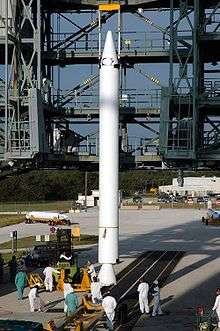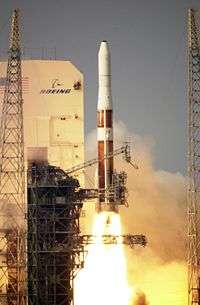Graphite-Epoxy Motor
 A GEM-40 is hoisted for attachment to a Delta II | |
| Manufacturer | Alliant Techsystems |
|---|---|
| Country of origin | United States |
| Used on | Delta II, Delta III, Delta IV |
| Launch history | |
| Status | Active |
|
| |
| GEM-40 | |
| Length | 11.4 m (449 in) |
| Diameter | 1.0 m (40 in) |
| Gross mass | 13,005 kg (28,671 lb) |
| Propellant mass | 11,767 kg (25,942 lb) |
| Thrust | 499 kN (112,200 lbf) |
| Specific impulse |
245 s (sea level) |
| Burn time | 63 seconds |
| Fuel | HTPB |
| GEM-46 | |
| Length | 12.6 m (495 in) |
| Diameter | 1.2 m (46 in) |
| Gross mass | 19,140 kg (42,196 lb) |
| Propellant mass | 16,860 kg (37,180 lb) |
| Thrust | 601 kN (135,200 lbf) |
| Specific impulse |
242 s (sea level) |
| Burn time | 77 seconds |
| Fuel | HTPB |
| GEM-60 | |
| Length | 13.2 m (518 in) |
| Diameter | 1.5 m (60 in) |
| Gross mass | 33,638 kg (74,158 lb) |
| Propellant mass | 29,697 kg (65,471 lb) |
| Thrust | 879 kN (197,500 lbf) |
| Specific impulse | 245 s (sea level) |
| Burn time | 91 seconds |
| Fuel | HTPB |
A Graphite-Epoxy Motor (GEM) is a solid-fuel rocket motor (SRM) produced by Orbital ATK (Formerly Alliant Techsystems) with an epoxy composite casing. GEM boosters have been used on the Delta II, Delta III, and Delta IV, and are planned for future use on the Atlas V and Vulcan.
Variants

- GEM-40
- The GEM-40 is a 40-inch-diameter (1,000 mm) SRM used on Delta II beginning in 1990. The use of composite materials allowed for booster casings several times lighter than the steel casings of the Castor 4 SRMs they replaced.[3] The first flight of a GEM-40 occurred in 1990 on a Delta II 7925.[4] Delta II vehicles can use three, four, or nine GEM-40s. When using three or four boosters, all GEM-40s ignite on the ground, while on Delta IIs using nine boosters six are ignited on the ground, and the remaining three are ignited in the air when the first six burn out.[5]
- GEM-46
- The GEM-46 was a lengthened 46-inch-diameter (1,200 mm) solid motor originally developed for Delta III. This solid motor variant also included thrust vector control (TVC) to help steer the vehicle. After the discontinuation of the Delta III, GEM-46 motors (without TVC)[5] were used on the Delta II to create the Delta II Heavy, which could only be launched from a modified pad at Cape Canaveral.[6] Both Delta III and Delta II-Heavy used nine GEM-46s, with six ignited on the ground and three air-lit.[7][8]
- GEM-60
- The GEM-60 is a 60-inch-diameter (1,500 mm) solid motor used on the Delta IV family of launch vehicles. These motors are available with and without TVC.[5] A Delta IV can use two or four GEM-60s, and is classified as a Delta IV Medium+ launch vehicle.[9]
- GEM-63
- The GEM-63 is being developed as a drop-in replacement for the Aerojet Rocketdyne AJ-60A booster used on the Atlas V. An extended GEM-63, the GEM-63XL, is planned for use on the Vulcan launch vehicle.[10]
Failures
On August 5, 1995, an air-lit GEM-40 failed to separate from a Delta II 7925 carrying Koreasat I. The excess mass of the booster resulted in the satellite reaching a lower than intended transfer orbit, which it was able to compensate for using on-board propellant.[11]
On January 17, 1997, a Delta II (Delta 241) exploded due to a catastrophic failure in a GEM-40. The failure triggered the launch vehicle's self-destruct function 13 seconds after ignition. An Air Force investigation determined that the motor's casing had been damaged prior to launch, resulting in the casing splitting open soon after ignition.[11]
External links
See also
References
- ↑ "GEM 40". Astronautix.com. Retrieved 24 July 2014.
- ↑ "GEM 46". Astronautix.com. Retrieved 24 July 2014.
- ↑ "Launch Vehicle: Solid Rocket Motors". JPL. Retrieved July 2014. Check date values in:
|access-date=(help) - ↑ "GEM 40". Astronautix. Retrieved July 2014. Check date values in:
|access-date=(help) - 1 2 3 "ATK Product Catalog" (PDF). ATK. Retrieved July 2014. Check date values in:
|access-date=(help) - ↑ "ULA Delta II successfully lofts OCO-2 to orbit". NASASpaceflight.com. Retrieved July 2014. Check date values in:
|access-date=(help) - ↑ "Delta II 7920H-10". Spaceflight 101. Retrieved July 2014. Check date values in:
|access-date=(help) - ↑ "Delta III Data Sheet". Space Launch Report. Retrieved July 2014. Check date values in:
|access-date=(help) - ↑ "Delta IV Medium+ (4,2)". Spaceflight 101. Retrieved July 2014. Check date values in:
|access-date=(help) - ↑ "Orbital ATK beats out Aerojet". Retrieved September 2015. Check date values in:
|access-date=(help) - 1 2 "Delta 2 Productive Years". Space Launch Report. Retrieved July 2014. Check date values in:
|access-date=(help)
